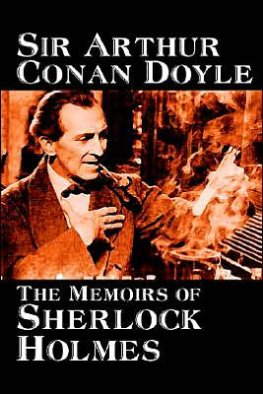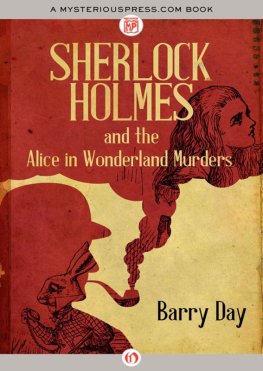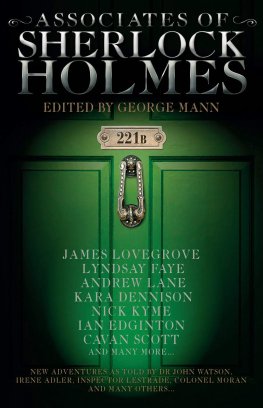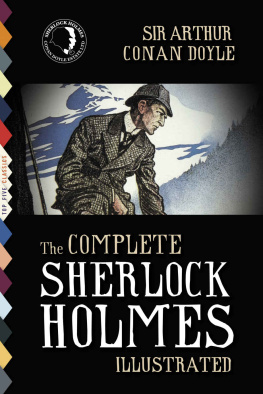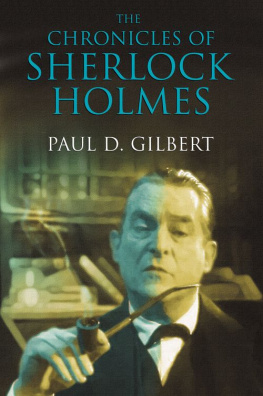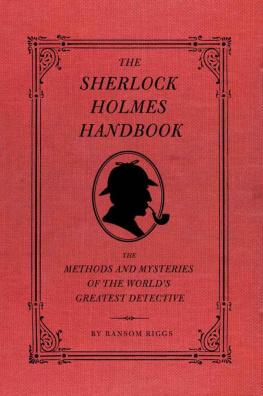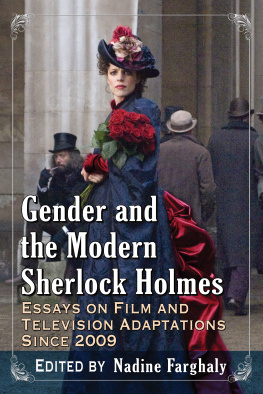Also by LYNNETTE PORTER
AND FROM MCFARLAND
Van Gogh in Popular Culture (2016)
The Doctor Who Franchise: American Influence, Fan Culture and the Spinoffs (2012)
Tarnished Heroes, Charming Villains and Modern Monsters: Science Fiction in Shades of Gray on 21st Century Television (2010)
Edited by Lynnette Porter
Sherlock Holmes for the 21st Century:
Essays on New Adaptations (2012)
Who Is Sherlock?
Essays on Identity in Modern Holmes Adaptations
Edited by LYNNETTE PORTER

McFarland & Company, Inc., Publishers
Jefferson, North Carolina
LIBRARY OF CONGRESS CATALOGUING DATA ARE AVAILABLE
BRITISH LIBRARY CATALOGUING DATA ARE AVAILABLE
e-ISBN: 978-1-4766-2654-3
2016 Lynnette Porter. All rights reserved
No part of this book may be reproduced or transmitted in any form or by any means, electronic or mechanical, including photocopying or recording, or by any information storage and retrieval system, without permission in writing from the publisher.
Front cover image of Benedict Cumberbatch as Sherlock Holmes in Sherlock, 2016 (PBS/Photofest)
McFarland & Company, Inc., Publishers
Box 611, Jefferson, North Carolina 28640
www.mcfarlandpub.com
Introduction
Although Sir Arthur Conan Doyles Sherlock Holmes canon, beginning with the 1887 publication of A Study in Scarlet, creates a vivid physical and mental portrait of the consulting detective, adaptations even during the authors lifetime have embellished the details of his more than 80 stories. Illustrator Sidney Paget made clothing choices, such as the deerstalker, that Conan Doyle never described and drew Holmes as more attractive than the author likely intended. When actor William Gillette immortalized Holmes on stage and later on screen in the first feature-length film about the Great Detective, Holmes not only became sexier, but his emotions also received a romantic overhaul. By the conclusion of Sherlock Holmes (1916), the title character acquired a love interest and was ready for marriage. Since then, the creative minds behind filmic adaptations have chosen to mold one or more aspects of Sherlock Holmess identity into the way they imagineor wantHolmes to be. Fans, too, are involved in the identity-creation process; through fan fiction, videos, and art, for example, they match their creative endeavors to the Sherlock Holmes in their head canon.
Nearly 130 years after the introduction of Sherlock Holmes to readers, the Great Detectives identity is being questioned, deconstructed, and reconstructed more than ever. In this book alone, the authors analyze not only who Sherlock Holmes is or has become, but why and how his identity has been formed in a specific way. The essays cover Sherlock Holmes and other familiar characters as they are presented in adaptations released since 2009: the films Sherlock Holmes (2009), Sherlock Holmes: A Game of Shadows (2011), and Mr. Holmes (2015), and television series Sherlock (2010present), which receives the most emphasis in this book, and Elementary (2012present). A range of fan responses to these filmic texts also is discussed in depth, including feminist criticism of female characters roles and identities, Johnlock (the sexual relationship between John Watson and Sherlock Holmes) as a way of reading the characters identities, and the interpretation of on-location filming and fan responses to news leaked from the Sherlock set, which helps to create a fan-specific identity for popular television characters. Such a range of analyses illustrates the continuing popularity of Sherlock Holmes and the passion with which adaptorswhether officially sanctioned by film or television production companies or unofficially but popularly shared among fan communitiesdefine him in new ways to better appreciate him as Other, learn from his experiences, or personally relate to him.
Many adaptations for film or television since 2009 emphasize the unique way Sherlock Holmes thinks as a way to understand who he really is. His identitywhether referring to a public persona or his deeply personal selfoften is determined by the way he processes information. Some stories take audiences inside Sherlocks mind, via mind palace (Sherlock) or Holmesvision (the Guy Ritchiedirected Sherlock Holmes film series). Other adaptations (such as Mr. Holmes) question who Holmes would be without his brilliant mind. Yet even this most obvious method of categorizing Holmes can lead different adaptors to different conclusions. In Sherlock, the title character self-identifies as a high-functioning sociopath, yet he defies medical diagnostic definitions. His mind is often described as like a machine (particularly a computer), yet recent adaptations reveal the emotional man behind the logical deductions. Who is Holmes of the magnificent mindand who would he be if he no longer were perceived as brilliant? Several authors explore the man behind the deductive process to examine Sherlock Holmess true identity.
Although Holmes is still considered machine-likeat least in the beginning of several adaptationshis emotions are revealed and dissected nearly as often as the consulting detective unravels clues and deduces crime scenes. Television adaptations Sherlock and Elementary chronicle Sherlock Holmess emotional development through episodic explorations of his relationship with Watson (John or Joan, respectively) and struggles with personal demons, ranging from drug use/abuse to archenemy Moriarty. On film, an elderly Mr. Holmes also struggles with his emotions as he unravels his last casethe one that led him to Sussex and a retirement of studying bees.
Holmess identity is often forged by cultural expectations. Whereas canon stories are most often set within the latter years of the Victorian (18371901) or in the Edwardian (19011910) era, even canon-era adaptors took creative license with their presentation of Sherlock Holmes. More than a century later, adaptors who seek to re-create canons now-historic setting must introduce a Sherlock Holmes who meets audience expectations of Victorian Holmes while appealing to a 21st-century audience. What is masculine or normal in one time and place may be interpreted very differently within a different cultural contextand cultural contexts may make Holmes seem even more Other than expected to audiences from a differing culture. As several contributors note, the Sherlock Holmes of canon-era adaptations is often a challenge to portray in historically accurate terms while also offering something new to audiences. Films Sherlock Holmes,Sherlock Holmes: A Game of Shadows, and Mr. Holmes and the special Sherlock episode The Abominable Bride align Holmes with a now-historic time period but also modernize the characters identity.
The critical lenses of narrative theory, religious symbolism, and psychoanalysis also can help viewers and readers clarify Holmess identity, especially as portrayed either within a specific Sherlock episode or across the whole series. An in-depth look at dialogue, set dressing, and filming techniques lead to insightful deductions about Sherlocks character development.
Other contributors analyze Sherlock Holmess behavior and the influences on him from childhood to adulthood. Although John Watson is a powerful influence in many adaptations (especially in the Sherlock Holmes films and Sherlock), he is not the only factor in determining how and why Holmes will act and how the public perceives him. He may be motivated by stress (including Post-Traumatic Stress Disorder) as much as love or the desire to solve a puzzle. He absorbs information about himself from others, especially those with whom he compares himself, whether brother Mycroft or nemesis Moriarty. Sherlock Holmes may perceive himself most clearly when he sees himself through the eyes of others.
Next page


